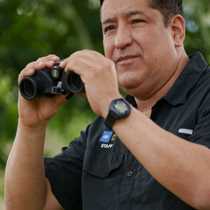Today we explored the western realms of this enchanted archipelago. Urbina Bay, our visitors’ site in the morning, is a place of great geological interest because an unusual event occurred as recent as 1954. In the scientific literature it is stated that a strong earthquake of 6.5 on the Richter scale took place in this area on June 4th, 1954 provoking a huge area adjacent to the coastline to uplift, leaving many marine creatures high and dry. It is still possible to see huge pieces of brain coral many feet inland. A healthy and thriving population of Galapagos land iguanas live around this area and we saw several of them along the trails. At the end of the walk, as the sun was stronger, we had the chance to cool off on the landing beach.
Once back onboard, the ship was repositioned to the south to Tagus Cove, a place where we spent the rest of the day. Before lunch and while navigating, naturalist Jonathan Aguas had a presentation on the Human History of the Galapagos Islands.
After lunch we had a very special workshop in which many of our guests learned how to make paper pearls. “Paper to Pearls” is one of the most successful and rewarding projects from the Lindblad Expeditions and National Geographic Artisan Fund. The idea is to bring a new ecological jewelry making techniques to the Galapagos Islands whcih originated in Africa and has spread to many other countries. The Fund decided we would teach local Galapagos artisans how to make “bead jewels” from waste paper, and bring a message of conservation and empowerment from abroad. Our guests participated today in our “Conservation in Action” initiative.
In the middle of the afternoon we took an early kayaking outing followed by a deep snorkeling session. We put on our gear to explore the underwater world by doing deep-water snorkeling in an exotic location, which today was optimal because it was sunny and the waters were warmer than expected. We were fortunate for we had great sea turtle, Galapagos sea lion, and penguin sightings.
In the late afternoon we disembarked at Tagus Cove for an extraordinary fast-paced hike along the rim of a volcanic tuff cone. We saw an inner lake, aptly named Darwin in honor of the great naturalist who was around Tagus Cove when he visited the Galapagos in 1835. Some guests opted to go for a Zodiac ride instead of the walk. The Zodiac ride was successful as well for we had the chance to cover a relatively long distance admiring the outstanding volcanic landscape and looking for wildlife.
As the day was coming to an end, all of us returned to the ship with the company of the last sunrays of the day with the dreamlike satisfaction of having spent a great day in one of the ultimate paradises on earth.







